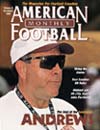AMERICAN FOOTBALL MONTHLY THE #1 RESOURCE FOR FOOTBALL COACHES
Article CategoriesAFM Magazine
|
Quarterbacking the Quarterbackby: Doug MartinOffensive coordinator/QB coach, East Carolina University © More from this issue The fundamentals of any position are important, and perhaps they are most crucial at the quarterback position. Quarterback fundamentals are both physical and mental. We have a list of beliefs in training a QB and they are: 1. Never take a sack. Know when to take a chance and when not to by considering down, distance and field position. 2. Throw against blitzes every time. Every play is a blitz until proven otherwise. This teaches the QB to be prepared, play under control and not to hurry against the blitz. 3. Protect the QB from tackle to tackle. We can throw hot off of a 5 technique rusher, but we must be solid inside. 4. Know where your package is. No sight adjustments for hot routes are built in. 5. Stress natural look offs. They help the QB learn to move his eyes. 6. QB must coach wide receivers so the quarterback s....The full article can only be seen by subscribers.
|
|
|||||||
| HOME |
MAGAZINE |
SUBSCRIBE | ONLINE COLUMNISTS | COACHING VIDEOS |
Copyright 2025, AmericanFootballMonthly.com
All Rights Reserved





